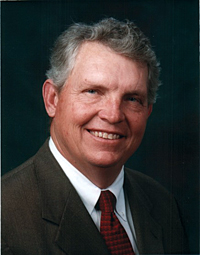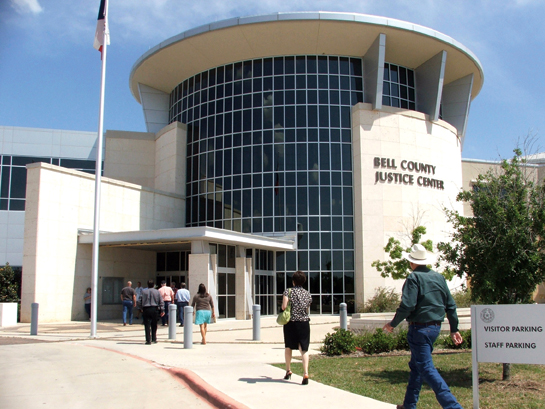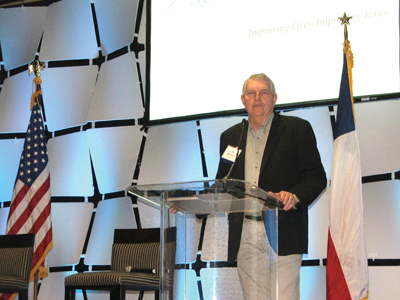In January 2003, County Progress published a feature article on Bell County Commissioner
Tim Brown spotlighting his unique contribution to the Bell County Courthouse restoration
(reprinted below). Ten years down the road, Brown is still serving Bell County.
2003…
 Commissioner Tim Brown coupled his love for Bell County with his skills as a stone worker to leave an indelible mark on the county’s courthouse – a historical marker fit for the newly restored building.
Commissioner Tim Brown coupled his love for Bell County with his skills as a stone worker to leave an indelible mark on the county’s courthouse – a historical marker fit for the newly restored building.
As the county was completing its courthouse restoration project, Brown noticed the courthouse had no historical marker. When the Bell County Historical Commission received the marker, Brown discovered the wall-style metal marker wasn’t compatible with the rusticated stone on the courthouse.
So Brown, who spends his days in construction and historic restoration, went to work designing a “free-standing monument that echoed the style of the courthouse.” He started with a piece of limestone purchased from a quarry and cut the stone to the desired style and size.
Brown said he expended about three working days of “elbow grease” with a hammer and chisel to complete the project using a technique he learned years ago in his study of restoration work.
“It was easier for me to do it than tell someone else how,” said Brown, who has worked on various stone-cutting projects through the years.
Brown estimates it would have cost the county between $1,200 and $1,500 to hire a skilled artisan to complete the marker. Brown’s time, of course, was donated, and he said the county spent around $200 for the stone he used.
Bell County Judge Jon Burrows said the marker is a “perfect addition to the courthouse” and something that wouldn’t have happened without Brown’s involvement.
And, as Burrows goes on to explain, this isn’t the first time Brown has donated his professional skills on a county project.
During the restoration project, the county discovered some stone steps needed to be replaced after the stone cutters had moved on to the next job. Enlisting the help of some county inmates, Brown was able to replace the steps in an afternoon with some steps that had been uncovered during the restoration, a job that would have cost the county some $7,000 to bring the stone workers back on the job.
“Tim has great artisan skills that he has used to the benefit of Bell County on several occasions without any fanfare because of his love for the county,” Burrows said.
Brown, a county commissioner for eight years (now 18 years), was born and raised in Bell County. He professes a deep interest in the county’s history and is proud to have been involved in the effort to “save the county’s courthouse before catastrophe.”
When Brown came on board as a commissioner, the county was just beginning its restoration effort. He took the lead to get the project underway and served as the county’s liaison throughout the project. His background in architecture, construction, restoration and art certainly benefited the county’s efforts.
The completed courthouse was dedicated in 2000, and Brown said the response has been positive. The county has seen an increase in walk-up tours since the restoration was finished.
The marker was dedicated on July 4, 2002.
While Brown humbly said he was “just trying to earn his keep” when he created the marker, his work to preserve Bell County’s history shows the dedication of a public servant who continues to make an impact on the county’s future.
2013…
County Progress asked Brown to provide a snapshot of the last decade including Bell County highlights and lessons learned over 10 years of growth and change.
The 2003 article focused on my personal, hands-on efforts to execute a couple of small projects to save the county a little money. Since then my role has shifted, and we’ve worked as a team as we’ve undertaken major capital projects that required a higher level of commitment. Rather than hammer and chisel work, we’ve all been involved in the tasks of strategic planning, assembling teams of architects and contractors, site selection and acquisition, project development, and contract management. Behind that was the process of issuing debt and dealing with the politics surrounding the whole process.
Growth:
We’ve had a busy 10 years. The restoration of our historic courthouse was just the first of several major capital projects, all driven by growth. Our population increased by more than 24 percent in the 1990s and by 30-plus percent in the most recent decade, exacerbating the overcrowded conditions in most of our facilities. The county had essentially outgrown all of our major facilities by the time I joined the commissioners court in 1995, so long-range planning, project development, and contract management were priorities of mine from the very beginning.
In the last decade we have survived the usual political controversy surrounding major projects and successfully completed the construction of a new jail, the renovation of our old jail, the renovation and repurposing of our old district courts building, and the construction of a new justice complex that houses both district and county courts, district and county clerks, district and county prosecutors, and one justice court. We have also built a multipurpose building that includes sections for document storage, sheriff’s evidence storage, and buildings and grounds equipment. In addition we have upgraded and expanded useable space in our communications center, our museum, and our Killeen Annex. We also recently completed an animal shelter. Furthermore, we have several smaller projects in the pipeline.
Change:
Bell County has indeed changed. High growth has changed the very fabric of our communities. Gone are the days when you knew everyone and communicated with your constituents at the coffee shop every morning. The scope and complexity of our projects have grown accordingly. Because of the impersonality of the world we live in today, the need for effective public communication is more important. We still don’t have a public information officer, per se, so we as elected officials have had to work harder to communicate. Given the Internet and other forms of social media, it is easier than ever for anyone who has an axe to grind to affect public opinion, and it is harder to counteract misinformation. It also seems the press favors sensation rather than information more than ever, so we can no longer rely on our local newspapers to provide an objective and factual presentation of any issue. Again, we just have to work harder to help the public understand what we’re doing and why.
In additional to our in-house projects, we can also celebrate our success in getting some major transportation projects underway. We are situated on the I-35 corridor, so we’ve been struggling with significant challenges related to our highway infrastructure since the mid-1990s. We are still much smaller than other major urban centers on the corridor, so competing for transportation dollars has been difficult; however, years of effort have finally paid off, and we now have almost a billion dollars worth of improvements completed, under contract or in development. It has taken more than mere advocacy. We long ago recognized that the funds are simply not there to develop all the needed improvements around the state, so we have focused on developing partnerships, utilizing innovative funding tools, and emphasizing the strategic importance of this segment to the system as a whole.
Lessons Learned:
If I have learned anything in 18 years, it is that nothing happens quickly, so we need to adjust our temporal perspective. It’s hard to do in the political realm, but we need to be looking 30, 40, 50 years down the road. The other major failing elected officials too often suffer from relates to a naïve view about the complexity of the challenges we face. Sometimes we think we know the answers before we really understand the questions. Complex problems seldom yield to simple solutions, and yet every election cycle brings a new wave of simple (or simplistic) proposals. My final observation is that the partnership we once enjoyed with our state leaders has evaporated (probably for the reasons stated above). It seems political expediency trumps good policy at every turn. Witness the perennial introduction of various proposals to “cap” local governments. Even though such measures have been repeatedly proven to corrupt the integrity of the ad valorem tax system and produce disastrous consequences for local governments everywhere they have been tried, such ideas keep coming up. All that said, lest we become too cynical, we need to remind ourselves that what we do is not only worthwhile, but is essential for the communities we live in.
















